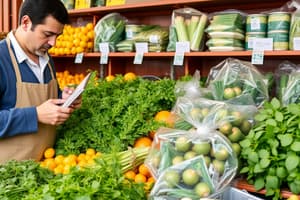Podcast
Questions and Answers
What primarily causes the seasonality of agricultural production?
What primarily causes the seasonality of agricultural production?
- Technological advancements
- Consumer demand fluctuations
- Urbanization trends
- Biological and physical conditions (correct)
Which months are typically considered peak months for agricultural work?
Which months are typically considered peak months for agricultural work?
- April - May - June
- August - September - October
- May - June - July (correct)
- January - February - March
What is a consequence of the seasonality of farm work?
What is a consequence of the seasonality of farm work?
- Stability in income throughout the year
- Increased year-round employment
- Consistent farming techniques
- Seasonal unemployment in agriculture (correct)
Which of the following is NOT a reason for the seasonality of agricultural production?
Which of the following is NOT a reason for the seasonality of agricultural production?
How does the seasonality of agricultural incomes affect farmers?
How does the seasonality of agricultural incomes affect farmers?
Which of the following crops typically allows farmers to earn income at more regular intervals?
Which of the following crops typically allows farmers to earn income at more regular intervals?
What are the two primary categories of effects resulting from the seasonality of agricultural production?
What are the two primary categories of effects resulting from the seasonality of agricultural production?
Which factor is least likely to influence the seasonality of agricultural industries?
Which factor is least likely to influence the seasonality of agricultural industries?
Flashcards
Seasonality of agricultural production
Seasonality of agricultural production
Agricultural goods are produced during specific periods, not throughout the year. This is due to climate and biological factors.
Internal effects of agricultural seasonality
Internal effects of agricultural seasonality
Impacts on farm work and income due to the seasonal nature of production.
Seasonality of farm work
Seasonality of farm work
The distribution of farm tasks varies according to crops and methods. Peak periods exist.
Seasonality of farm incomes
Seasonality of farm incomes
Signup and view all the flashcards
External effects of seasonal production
External effects of seasonal production
Signup and view all the flashcards
Agricultural seasonality causes
Agricultural seasonality causes
Signup and view all the flashcards
Seasonality of agricultural industries
Seasonality of agricultural industries
Signup and view all the flashcards
Temporal distribution of agricultural production
Temporal distribution of agricultural production
Signup and view all the flashcards
Study Notes
Economic Characteristics of Agriculture
- Agricultural products are seasonal, meaning they are only produced during specific periods of the year.
- Examples include summer and winter crops.
- Unlike consumer and industrial goods, agricultural goods are not continuously produced.
- Seasonality is due to factors such as:
- Climate conditions (temperature, wind, humidity)
- Biological factors (soil, insects).
- Agricultural operations occur in specific seasons.
- This seasonal production impacts farm work scheduling.
- Peak agricultural labor demand occurs in specific months, like May, June, July, September, and October.
- Seasonal unemployment results from varying farm work demands throughout the year.
- Farmers' income is often seasonal.
- Crops like wheat, cotton, and rice have income concentrated in harvest seasons.
- Animal products like dairy, eggs, poultry, and fish have relatively consistent incomes throughout the year.
- Agricultural industries are sometimes seasonal, which creates problems for those who depend on raw agricultural materials.
- Production is often not distributed evenly across the year.
- Storage processes are needed to address uneven production.
- The price of a stored product factors in storage costs and returns on investment.
Studying That Suits You
Use AI to generate personalized quizzes and flashcards to suit your learning preferences.
Related Documents
Description
Explore the seasonal nature of agricultural production and its economic impact in this quiz. Discover how climate, biological factors, and labor demand shape the agricultural calendar. Understand the implications of seasonal income variability for farmers.




